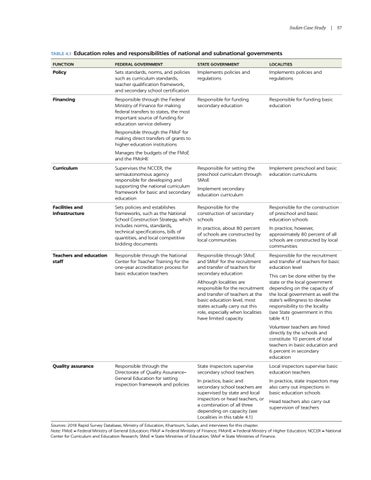Sudan Case Study | 57
TABLE 4.1 Education
roles and responsibilities of national and subnational governments
FUNCTION
FEDERAL GOVERNMENT
STATE GOVERNMENT
LOCALITIES
Policy
Sets standards, norms, and policies such as curriculum standards, teacher qualification framework, and secondary school certification
Implements policies and regulations
Implements policies and regulations
Financing
Responsible through the Federal Ministry of Finance for making federal transfers to states, the most important source of funding for education service delivery
Responsible for funding secondary education
Responsible for funding basic education
Supervises the NCCER, the semiautonomous agency responsible for developing and supporting the national curriculum framework for basic and secondary education
Responsible for setting the preschool curriculum through SMoE
Implement preschool and basic education curriculums
Sets policies and establishes frameworks, such as the National School Construction Strategy, which includes norms, standards, technical specifications, bills of quantities, and local competitive bidding documents
Responsible for the construction of secondary schools
Responsible for the construction of preschool and basic education schools
In practice, about 80 percent of schools are constructed by local communities
In practice, however, approximately 80 percent of all schools are constructed by local communities
Responsible through the National Center for Teacher Training for the one-year accreditation process for basic education teachers
Responsible through SMoE and SMoF for the recruitment and transfer of teachers for secondary education
Responsible for the recruitment and transfer of teachers for basic education level
Responsible through the FMoF for making direct transfers of grants to higher education institutions Manages the budgets of the FMoE and the FMoHE Curriculum
Facilities and infrastructure
Teachers and education staff
Implement secondary education curriculum
Although localities are responsible for the recruitment and transfer of teachers at the basic education level, most states actually carry out this role, especially when localities have limited capacity
This can be done either by the state or the local government depending on the capacity of the local government as well the state’s willingness to devolve responsibility to the locality (see State government in this table 4.1) Volunteer teachers are hired directly by the schools and constitute 10 percent of total teachers in basic education and 6 percent in secondary education
Quality assurance
Responsible through the Directorate of Quality Assurance– General Education for setting inspection framework and policies
State inspectors supervise secondary school teachers
Local inspectors supervise basic education teachers
In practice, basic and secondary school teachers are supervised by state and local inspectors or head teachers, or a combination of all three depending on capacity (see Localities in this table 4.1)
In practice, state inspectors may also carry out inspections in basic education schools Head teachers also carry out supervision of teachers
Sources: 2018 Rapid Survey Database, Ministry of Education, Khartoum, Sudan, and interviews for this chapter. Note: FMoE = Federal Ministry of General Education; FMoF = Federal Ministry of Finance; FMoHE = Federal Ministry of Higher Education; NCCER = National Center for Curriculum and Education Research; SMoE = State Ministries of Education; SMoF = State Ministries of Finance.






